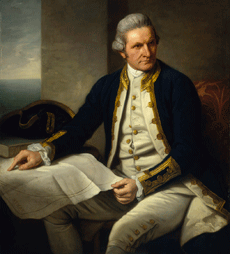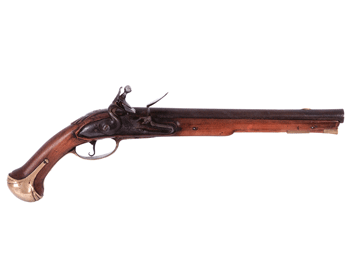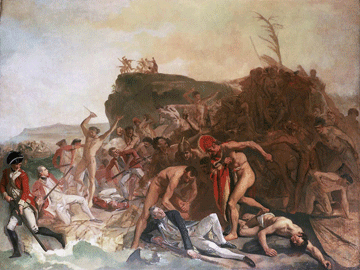|
Captain James Cook
Answer
to Name
This Famous Person Game - May 2016
by Mike McLeod
|
 |
In the photo, Captain James Cook is holding a map for a specific reason
- he was a great cartographer. He mapped Newfoundland, the east coast of Australia, New Zealand, and many islands during his three voyages to the Pacific Ocean, north and south. He was also a great mariner; he circumnavigated the world.
Born in Yorkshire, England, on October 27, 1778, into a farming family, Cook eventually began his naval career working on a ship hauling coal. He then moved onto other ships as a merchant sailor and then in 1755, he enlisted in the Royal Navy.
In 1768, Cook was commissioned a lieutenant and given the command of a ship for a scientific mission to Tahiti to map the transit of Venus across the sun happening in 1769. This endeavor was to gather the data needed for determining longitude on a worldwide basis. At the same time, many astronomers around the world were also charting Venus’ transit, but none were successful. However, Cook also had a secret mission on this voyage that was successful. After the observation of the transit, Cook opened orders from the Admiralty directing him to find the then-postulated land of Australia.
|

Captain James Cook
|
He sailed on to New Zealand, which he mapped, and then onto Australia, being the first European to land there, as far as records show. Consequently, Australia became a British colony.
On his third voyage to the Pacific, Capt. Cook landed on Hawaii in 1778. After first contact there, he sailed north to find a northwest passage from the Pacific to the Atlantic. Failing that but mapping much of the Alaskan coast and the Northeast, he returned to the Hawaiian Islands in 1779, which he named the Sandwich Islands after John Montagu, the 4th Earl of Sandwich and the head of the British Navy’s Admiralty.
In Hawaii, one his ship’s small boats was taken, and Cook endeavored unsuccessfully to get it back. He then went to the take the Hawaiian King King Kalani'opu'u and was attacked and killed on February 14, 1779. Four of his ship’s marines were also killed at this time.
|

|

|
|
Cook’s flintlock pistol.
(Photo courtesy of Mossgreen, mossgreen.com.au)
|
The Death of Captain James Cook, 14 February 1779, by Johann Zoffany, circa 1795.
|
The natives took Cook’s body, and as their custom was at the time for those they respected, they prepared his body and removed the bones as relics. Part of Cook’s remains were returned to his crew for burial at sea.
The actual spear that was used in the attack on him was reportedly taken by an officer on board Cook’s ship Endeavor, and it was later made into a walking cane. That cane was sold at auction by Lyon & Turnbull in the U.K. for £135 in 2003. The cane was gold-mounted and engraved with: "From Adml. C.B.H. Ross C.B. To Admiral Sir David Milne G.C.B. Made of the spear which killed Captn. Cook R.N." Another incredible historical piece, Capt. Cook’s Continental flintlock pistol, with a 13-inch-long barrel, was auctioned by Leski Auctions in Australia for $227,100 in 2013.
A statue to James Cook stands today in Waimea, Kauai, commemorating his first contact with Hawaii.
Julie Kimbrell of The Old School Antique Mall in Sylva, N.C., and Ted Carlton of Utah correctly identified Capt. James Cook.
--------------------------------------------
Credit: Wikipedia.org
Unless otherwise credited, all photos are public domain, PD-US.)
Learn
about more Famous People
|